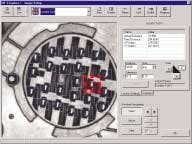Vision-inspection system checks automotive parts
In the past, the mass-production of parts on conventional assembly lines required extensive and complicated setups. Now, in the automotive industry, in particular, small production lots are common. This has mandated substantial changes to assembly and inspection procedures; it also confronts vision-system integrators with complex design challenges.
To meet these challenges, Avalon Vision Solutions (Atlanta, GA, USA; www.avalonvisionsolutions.com) has developed a vision-inspection system that monitors the sequential assembly of multiple products on a common assembly line. This approach, known as In-Line Vehicle Sequencing (ILVS), assembles different parts in order on an automotive production line. "Implementing this assembly procedure complicates the operator's tasks, since the assembly line has to be configured for each part being assembled," says Bill Nicol, Avalon vice president of sales and marketing. "In addition, automated inspection technology is required to minimize errors in the part being assembled," he adds.
To overcome assembly limitations, Avalon's QualityStation system with PlantVision 7 software comprises a vision system with event-driven I/O architecture that permits one active program to accommodate several different product models. The setup for each product is stored in QualityStation as an event. When the system controller receives an input signal that identifies the event, it executes the inspection criteria for that event. According to Nicol, QualityStation makes setups and statistical process control (SPC) data acquisition and reporting less complicated than running different programs for each product model.
To initialize the system, plant-floor personnel set up the inspection procedure through a touchscreen interface for the part to be assembled. After the part is assembled, a trigger signal activates as many as 24 cameras (the number varies with the application) to capture the images required for inspection. A barcode is then read by a separate HHP-IT 3800 LED barcode scanner from Hand Held Products (Skaneateles Falls, NY, USA; www.hhp.com) that informs the system which part is to be inspected. After Meteor-II frame grabbers from Matrox Imaging (Dorval, QC, Canada; www.matrox/imaging) capture the required images, the part is inspected according to procedures specified by the plant-floor technician.
SmartWindow tools for the touchscreen interface provide a human-machine interface (HMI) that calls modules from the Matrox Imaging Library (MIL), such as MIL's pattern-matching functions. All the results from the inspection procedures, including image data, are logged into Avalon's ProcessRx SPC database, which is accessible through the Internet.
Whereas the HMI supports different input types, including barcodes, Ethernet protocols, and serial interfaces, the SPC database supports image data from multiple cameras. Because QualityStation was developed for factory-automation applications, the system works despite difficult lighting conditions in the plant. A near-infrared (NIR) camera, called NightHawk, was developed from available camera components and customized to satisfy such lighting requirements. It uses an XC 75 sensor module from Sony Electronics (Park Ridge, NJ, USA; www.sony.com/videocameras) with an IR pass filter on the lens to filter out the visible ambient. "For higher-resolution inspection," says Nicol "we use the Sony XC-EI 50 1/2-in. CCD camera that has a boosted NIR range with an IR pass filter."
Currently, a dozen Quality Station systems are in operation, including the ILVS applications in Detroit, MI, and Monterey, Mexico. According to president and chief executive officer Ed Kachnic, Avalon Vision Solutions plans to integrate additional SmartWindow tools to incorporate the MIL optical-character-recognition and geometric-model-finder modules.

